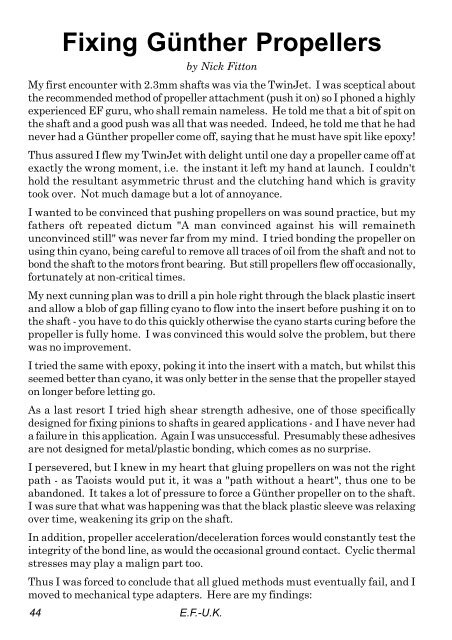electric flight uk - British Electric Flight Association - Jan Bassett's
electric flight uk - British Electric Flight Association - Jan Bassett's
electric flight uk - British Electric Flight Association - Jan Bassett's
Create successful ePaper yourself
Turn your PDF publications into a flip-book with our unique Google optimized e-Paper software.
Fixing Günther Propellers<br />
by Nick Fitton<br />
My first encounter with 2.3mm shafts was via the TwinJet. I was sceptical about<br />
the recommended method of propeller attachment (push it on) so I phoned a highly<br />
experienced EF guru, who shall remain nameless. He told me that a bit of spit on<br />
the shaft and a good push was all that was needed. Indeed, he told me that he had<br />
never had a Günther propeller come off, saying that he must have spit like epoxy!<br />
Thus assured I flew my TwinJet with delight until one day a propeller came off at<br />
exactly the wrong moment, i.e. the instant it left my hand at launch. I couldn't<br />
hold the resultant asymmetric thrust and the clutching hand which is gravity<br />
took over. Not much damage but a lot of annoyance.<br />
I wanted to be convinced that pushing propellers on was sound practice, but my<br />
fathers oft repeated dictum "A man convinced against his will remaineth<br />
unconvinced still" was never far from my mind. I tried bonding the propeller on<br />
using thin cyano, being careful to remove all traces of oil from the shaft and not to<br />
bond the shaft to the motors front bearing. But still propellers flew off occasionally,<br />
fortunately at non-critical times.<br />
My next cunning plan was to drill a pin hole right through the black plastic insert<br />
and allow a blob of gap filling cyano to flow into the insert before pushing it on to<br />
the shaft - you have to do this quickly otherwise the cyano starts curing before the<br />
propeller is fully home. I was convinced this would solve the problem, but there<br />
was no improvement.<br />
I tried the same with epoxy, poking it into the insert with a match, but whilst this<br />
seemed better than cyano, it was only better in the sense that the propeller stayed<br />
on longer before letting go.<br />
As a last resort I tried high shear strength adhesive, one of those specifically<br />
designed for fixing pinions to shafts in geared applications - and I have never had<br />
a failure in this application. Again I was unsuccessful. Presumably these adhesives<br />
are not designed for metal/plastic bonding, which comes as no surprise.<br />
I persevered, but I knew in my heart that gluing propellers on was not the right<br />
path - as Taoists would put it, it was a "path without a heart", thus one to be<br />
abandoned. It takes a lot of pressure to force a Günther propeller on to the shaft.<br />
I was sure that what was happening was that the black plastic sleeve was relaxing<br />
over time, weakening its grip on the shaft.<br />
In addition, propeller acceleration/deceleration forces would constantly test the<br />
integrity of the bond line, as would the occasional ground contact. Cyclic thermal<br />
stresses may play a malign part too.<br />
Thus I was forced to conclude that all glued methods must eventually fail, and I<br />
moved to mechanical type adapters. Here are my findings:<br />
44 E.F.-U.K.















